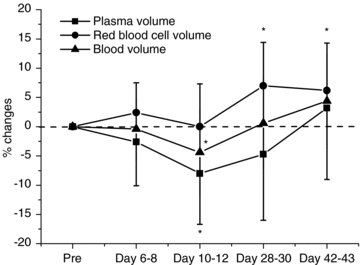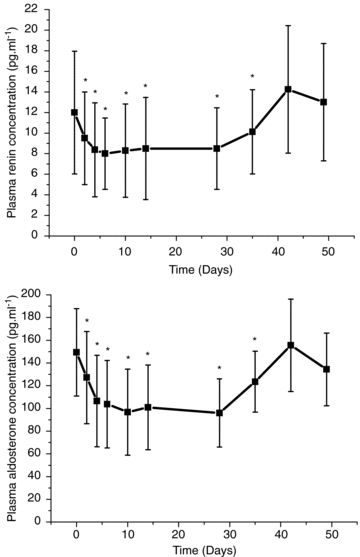Erythropoietin down-regulates proximal renal tubular reabsorption and causes a fall in glomerular filtration rate in humans
- PMID: 20724370
- PMCID: PMC3082091
- DOI: 10.1113/jphysiol.2010.194241
Erythropoietin down-regulates proximal renal tubular reabsorption and causes a fall in glomerular filtration rate in humans
Abstract
Recombinant human erythropoietin (rHuEPO) elevates haemoglobin concentration both by increasing red blood cell volume and by a decrease in plasma volume. This study delineates the association of rHuEPO-induced changes in blood volumes with changes in the renin–aldosterone system and renal function. Sixteen healthy males were given rHuEPO for 28 days in doses raising the haematocrit to 48.3±4.1%.Renal clearance studieswith urine collections (N = 8) were done at baseline and at days 4, 11, 29 and 42. Glomerular filtration rate (GFR) was measured by 51Cr-EDTA.Renal clearance of lithium (CLi)was used as an index of proximal tubular outflow and to assess segmental renal tubular handling of sodium and water. rHuEPO-induced increases in haematocrit occurred from day 10 onwards and was caused by both an increase in red cell volume and a fall in plasma volume. Well before that (from day 2 and throughout the treatment time), rHuEPO decreased plasma levels of renin and aldosterone (N = 8) by 21–33% (P < 0.05) and 15–36% (P < 0.05), respectively. After cessation of rHuEPO, values returned to baseline. On days 11 and 29, CLi increased (P < 0.02) indicating a significant 10–16% decrease in absolute proximal reabsorption of sodium and water (APR = GFR − CLi, P < 0.05). GFR decreased slightly, albeit significantly, on day 4 (P < 0.05). In conclusion, rHuEPO promptly, and before any changes in blood volumes and haematocrit can be detected, causes a down-regulation of the renin–aldosterone system. The results are compatible with a rHuEPO-induced reduction in proximal reabsorption rate leading to activation of the tubuloglomerular feedback mechanism and a fall in GFR. Therefore, treatment with rHuEPO may result in suppression of endogenous EPO synthesis secondary to a decrease in intrarenal oxygen consumption.
Figures



Similar articles
-
Recombinant erythropoietin acutely decreases renal perfusion and decouples the renin-angiotensin-aldosterone system.Physiol Rep. 2018 Mar;6(5):e13573. doi: 10.14814/phy2.13573. Physiol Rep. 2018. PMID: 29504258 Free PMC article. Clinical Trial.
-
Renal tubular reabsorption of sodium and water during infusion of low-dose dopamine in normal man.Clin Sci (Lond). 1990 May;78(5):503-7. doi: 10.1042/cs0780503. Clin Sci (Lond). 1990. PMID: 2162278
-
The acute effect of acetazolamide on glomerular filtration rate and proximal tubular reabsorption of sodium and water in normal man.Scand J Clin Lab Invest. 1989 Oct;49(6):583-7. doi: 10.3109/00365518909089139. Scand J Clin Lab Invest. 1989. PMID: 2595250
-
Effects of recombinant human erythropoietin in normal humans.J Physiol. 2011 Mar 15;589(Pt 6):1265-71. doi: 10.1113/jphysiol.2010.195917. Epub 2010 Aug 31. J Physiol. 2011. PMID: 20807784 Free PMC article. Review.
-
Lithium clearance in the evaluation of segmental renal tubular reabsorption of sodium and water in diabetes mellitus.Dan Med Bull. 1994 Feb;41(1):23-37. Dan Med Bull. 1994. PMID: 8187564 Review.
Cited by
-
The Increase in Hemoglobin Concentration With Altitude Differs Between World Regions and Is Less in Children Than in Adults.Hemasphere. 2023 Apr 5;7(4):e854. doi: 10.1097/HS9.0000000000000854. eCollection 2023 Apr. Hemasphere. 2023. PMID: 37038466 Free PMC article.
-
Recombinant erythropoietin in humans has a prolonged effect on circulating erythropoietin isoform distribution.PLoS One. 2014 Oct 21;9(10):e110903. doi: 10.1371/journal.pone.0110903. eCollection 2014. PLoS One. 2014. PMID: 25335123 Free PMC article. Clinical Trial.
-
Renin cells in homeostasis, regeneration and immune defence mechanisms.Nat Rev Nephrol. 2018 Apr;14(4):231-245. doi: 10.1038/nrneph.2017.186. Epub 2018 Jan 30. Nat Rev Nephrol. 2018. PMID: 29380818 Free PMC article. Review.
-
Erythropoietin treatment enhances muscle mitochondrial capacity in humans.Front Physiol. 2012 Mar 13;3:50. doi: 10.3389/fphys.2012.00050. eCollection 2012. Front Physiol. 2012. PMID: 22419911 Free PMC article.
-
Effect of Erythropoietin on Postresuscitation Renal Function in a Swine Model of Ventricular Fibrillation.Biomed Res Int. 2016;2016:3567275. doi: 10.1155/2016/3567275. Epub 2016 Oct 25. Biomed Res Int. 2016. PMID: 27847811 Free PMC article.
References
-
- Arcasoy MO. The non-haematopoietic biological effects of erythropoietin. Br J Haematol. 2008;141:14–31. - PubMed
-
- Bode-Böger SM, Böger RH, Kuhn M, Radermacher J, Frölich JC. Recombinant human erythropoietin enhances vasoconstrictor tone via endothelin-1 and constrictor prostanoids. Kidney Int. 1996;50:1255–1261. - PubMed
-
- Briggs J, Skott O, Schnermann J. Cellular mechanisms within the juxtaglomerular apparatus. Am J Hypertens. 1990;3:76–80. - PubMed
-
- Briggs JP, Schnermann J. The tubuloglomerular feedback mechanism: functional and biochemical aspects. Annu Rev Physiol. 1987;49:251–273. - PubMed
-
- Bröchner-Mortensen J. A simple method for the determination of glomerular filtration rate. Scand J Clin Lab Invest. 1972;30:271–274. - PubMed
Publication types
MeSH terms
Substances
LinkOut - more resources
Full Text Sources
Medical
Research Materials
Miscellaneous

